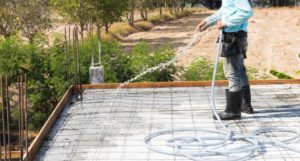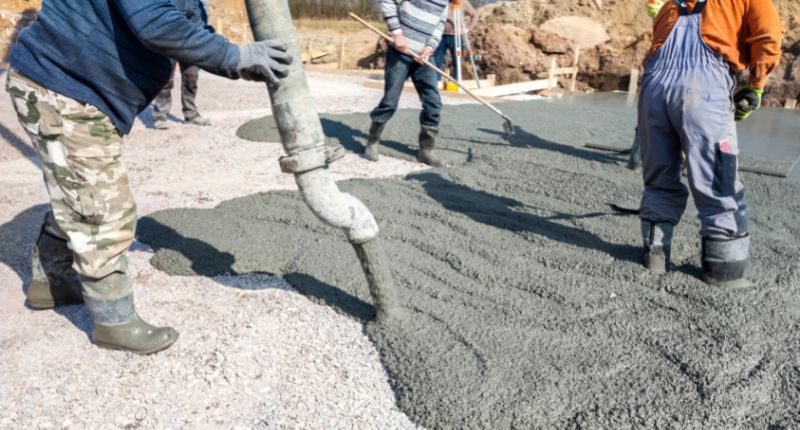- Pricing for a concrete slab ranges between $75 and $100 per square metre.
- Size, purpose, location and more can all impact the cost of a concrete slab.
- Getting several quotes is recommended, including from small local companies.
The cost of concrete per square metre can vary widely depending on the type, with plain concrete beginning at $60/m2 and more decorative styles ranging into the $100/m2 mark.
As for the cubic metre, the cost of concrete can range from $200 to $300.
Here at The Property Tribune, we’ve previously covered the cost of concrete per square metre and per cubic metre.
But what exactly does this information mean in the context of having a concrete slab laid?
What is a concrete slab?
A concrete slab is a flat, horizontal area of concrete laid for the purpose of construction. It serves as a structural component, or foundation, for a building to be constructed on top of.
Concrete slabs are most commonly seen used as housing or shed foundations and driveways and range from four inches for residential construction up to six inches for projects with a need for higher weight bearing.
Concrete is typically poured from a concrete truck or mixed in a wheelbarrow using concrete cement bags and water. For larger projects that require extra strength in the foundation, rebar or steel reinforcement may be used.
What’s the difference between a concrete and cement slab?
When we talk of concrete, it’s easy to mistake concrete and cement as one and the same.
Cement is a component of concrete, but the terms cannot in fact be used interchangeably. Concrete is composed of cement, aggregate (typically sand, stone or gravel), and water.
Cement can be used on its own, though it is mostly used in small projects or for repairing damage to concrete. It is predominantly used as an ingredient of concrete as a cement slab is not as durable as concrete, and can be prone to cracking.
A cement slab is also generally cheaper than a concrete slab, however the downfalls in strength and durability account for this. Concrete, in comparison, can last more than five decades when professionally laid and maintained.
What are the types of concrete slabs?
Your concreter may choose from a range of slab types to best fit your project. We’ve explained three of the most common slab types seen in professional construction below.
Waffle slab
The waffle slab is perhaps one of the most popular types of concreting used in modern Australian homes. The slab is constructed on the ground and reinforced with square grids running in two directions.
Once completed, the slab sits 400mm above the ground and the surrounding ground is typically raised to cover the exposed slab.
Raft slab
A raft slab typically consists of a 100mm thick concrete slab supported by internal beams and reinforced with steel. Though the minimum thickness of the slab must be 100mm, slabs that require stronger weight-bearing capacity can be up to 150mm.
This type of slab is one of the simplest to install, and is most suited for projects that need to cover a large area but have a low-bearing soil type.
Suspended slab
Suspended slabs differ in that they are constructed above ground level, as the name suggests. A suspended slab is mainly used for commercial projects, though it’s not unheard of for them to be used in residential construction.
Suspended slabs can come in the form of a one-way slab which is supported by beams on two sides or a two-way slab which is supported by beams on all four sides.

What factors influence the cost of a concrete slab?
Size and purpose of the slab
As expected, the size of the slab will largely influence the cost of the job as more materials, time, and labour will be required. The purpose of the slab is also an important factor, as these details are crucial for your concreter to know to determine how thick the slab should be, whether it should be reinforced, and what type of slab to lay.
Location
Whenever you’re looking at having professional home improvements done, it’s important that you take into account the local market conditions. For example, the availability of materials and labour in your has a huge influence. A market that is saturated with concreters will typically be cheaper, whereas if concreters are scarce, you can expect to pay more for their expertise.
The location of your concrete slab will also determine the pricing, as soil and moisture conditions will impact the type of concrete slab that can be laid.
Accessibility
Like any construction job, the accessibility of the site is of high importance. A site that is difficult to maneuver, particularly if a concrete truck is needed to complete the job, will end up costing you more.
Size of the concreting company
A common misconception is that larger companies with more resources will automatically mean a cheaper price. In fact, some large concreting companies actually charge a premium for smaller jobs as they prefer to focus on larger projects. If you’re seeking a concreter for an at-home project, it’s worth investigating small local businesses as they generally keep prices low to attract and retain their customer base.
So how much does a concrete slab cost in 2023?
Now that we’ve covered the basics of having a concrete slab laid, let’s take a look at average pricing.
As always, it’s recommended that you seek out professional concreters who can provide you with a portfolio of their work and references that can attest to their abilities.
Getting a few quotes from different companies is always a good idea, as you can also use the consultation to help determine what is most suited to your needs.
Generally, prices for a concrete slab should range between $75 – $100 per square metre.
For a more in-depth pricing guide, however, here’s roughly what you can expect to pay for the following concrete slabs:
- Standard 10m x 10m slab: $7,500 – $11,000
- Single garage (3.6m x 6m): $1,600 – $2,400
- Small shed (6m x 7m): $3,100 – $4,600
- Large shed (12m x 13m): $11,700 x $17,200








